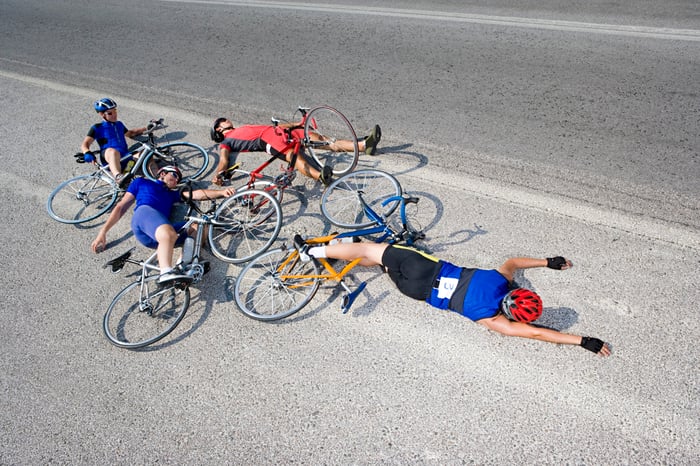If you've been an investor for a few decades, you're probably familiar with the great Internet bubble that burst in early 2000, severely shrinking many portfolios. (The S&P 500 fell by 9.1% that year, followed by drops of 11.9% and 22.1%, respectively, in the next years.) That was followed by a housing bubble that began bursting in 2006, contributing to a 37% drop in the S&P 500 in 2008.
Financial bubbles bursting aren't anything new, as readers of financial history know. There was a very famous tulip bubble, of all things, in Holland in the 1600s. Few, though, know about the also-impressive bicycle bubble in Britain in the 1800s. It's one of many bubbles detailed in the new book Boom and Bust: A Global History of Financial Bubbles by William Quinn and John D. Turner.

Image source: Getty Images.
Here's a look at some aspects of the bicycle bubble, along with lessons they offer for investors today. (Reading up on financial history can make you a much more effective investor.)
The great British bicycle bubble, in a nutshell
Bicycles had been around for a long time, but it was only in the late 1800s that they became extremely popular -- due in large part to improvements made to them, such as pneumatic tires that offered smoother rides and chains to provide leverage without requiring a huge front wheel.
As the prevalence of bikes increased, so did business activity related to bikes. Birmingham was a center for cycling, and bicycle manufacturers there numbered 72 in 1889 -- with that number surging to 177 by 1895, per Quinn and Turner. They also note that patents related to bicycles went from 595 in 1890 to 4,269 by 1896, and they ended up representing 15% of all new patents issued.
During this boom, there was a frenzy of investing in bicycle companies, with some investors getting rich and many investors losing their shirts. There was an early form of leveraged buyouts going on at the time, with some folks borrowing a lot of money, buying bicycle-related companies, and then selling shares of those companies to the public, while pocketing much more than they paid for the companies.
Let's look at some mistakes made during this bubble that are instructive to investors today.
Mistake No. 1: Ignoring the character of key players
Just like many investors today, investors of yesteryear often were not aware of the character of the people behind the investments they made. Had they taken the time to try to meet them, ask around about them, or see if they had made news in the past, they might have found that some of them had not succeeded in previous businesses.
Today, a lot can be learned about the people leading various public companies, via some online research and from the folks themselves. CEOs, for example, appear before investors at annual meetings and pen annual letters to shareholders. Assessing how candid and forthcoming management is can help lead you to more promising investments. Analyst Laura Rittenhouse and her team issue annual candor rankings for CEOs -- which you can check out anytime. (In 2019, financial payments specialist Square ranked No. 1.)
Mistake No. 2: Not thinking enough about a company's big or small picture
Bicycle investors during the bubble were often quick to invest in companies without doing much research into them. Of course, doing research back then was far less easy than it is today. Otherwise, the investors might have been able to spot poor fundamentals via financial disclosures. Many companies, for example, had just recently been launched and didn't have solid track records of growing revenue and earnings. Some may have carried steep debt and little cash, too. Investors also probably didn't sufficiently appreciate that with so many bicycle companies around, there was a lot of competition, which can put pressure on pricing and make many businesses simply unsustainable.
Today we investors still need to dig into the companies we're considering for our portfolios. After all, it's our precious hard-earned dollars that will be on the line, along with the bigger sums we hope they will turn into over time. It's very easy to research companies at their websites today, though, and to review their financial statements and search for news stories about them. Many good brokerages offer access to a wide range of Wall Street analyst reports on companies, as well.

Image source: Getty Images.
Mistake No. 3: Doubling down
As with many financial bubbles, the bicycle bubble didn't burst all at once. Like the housing and internet bubbles of recent decades, it happened over a number of years. Thus, many investors kept investing -- buying more shares as prices fell further. That's one of many investing mistakes many people still make -- often because we are determined to make up our losses over time, when it might be smarter to simply bail out of companies in which we no longer have much confidence, transferring any remaining dollars to our best ideas.
Mistake No. 4: Falling for hype and scams
During the bicycle bubble, there was a lot of hyping going one. Quinn and Turner recount one example, where two businessmen (one of whom had recently been in the business of manufacturing items with ostrich feathers, not any transportation enterprise) joined forces and created one company to place orders with another in order to make that company look like it had a lot of business. That's fraud -- a scam. There was also a lot of hyping in print, with would-be investors lured with suggestions of would-be great fortunes to be made in various investments.
Such stuff goes on today, as well, typically in regard to penny stocks -- those trading for around $5 per share or less. A common scam is the "pump-and-dump" scheme, where a hyper buys many shares of a tiny company and then promotes it heavily online and in newsletters. That leads gullible and naïve investors to pile in, sending the share price up. The hyper then sells their own shares, sending the share price crashing and delivering losses to the victims of the scam.
Mistake No. 5: Focusing on the positive more than the negative
Finally, many bicycle investors of yore, just like investors of today, succumbed to "confirmation bias," a psychological term for when we favor news and information that supports our views. (There are many biases that can hurt investors.) With confirmation bias, if we believe we're going to make good money investing in certain bicycle companies -- or in certain cloud computing companies or vaccine-developing companies -- we will take to heart any news stories or information reflecting how promising they are, and we may ignore or discount any suggestions of risks.
The media often doesn't help us, either. Back in the bicycle bubble days, there was much media coverage of growing bicycle businesses, and some criticism and warnings about it, too. Unfortunately, hypers were able to pay to have their companies promoted, with puff pieces written about them. Investors would have done well to try to find the most trustworthy sources of information. One publication that warned investors of ongoing manipulations was The Economist, a journal that's still around today!
Periods of euphoric speculation seem to inevitably occur every now and then (with some suggestion we're in one now). It's worth reading up on bubbles of the past to learn more about how they happen and how you might avoid them. Quinn and Turner's Boom and Bust book is a good start. Also good are A Short History of Financial Euphoria by John Kenneth Galbraith, Extraordinary Popular Delusions and The Madness of Crowds by Charles Mackay, and Devil Take the Hindmost: A History of Financial Speculation by Edward Chancellor.




